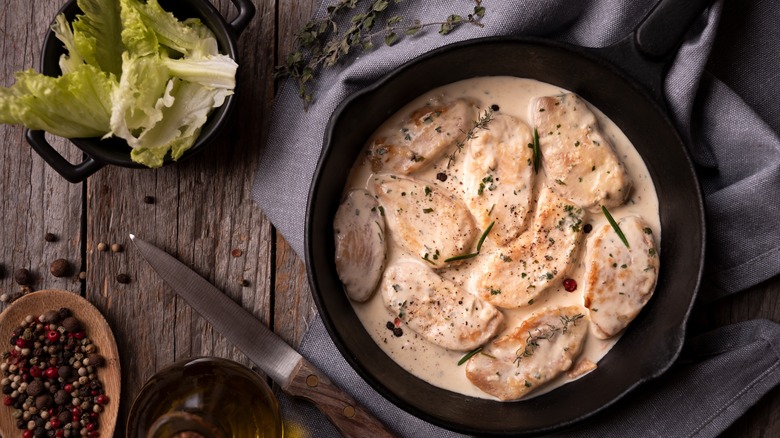Why Your Homemade Pan Sauces Don't Look Like A Restaurant's
Pan sauces are as delicious as they are ingenious. Throwing one together allows any home cook to maximize the potential of their ingredients. Left with bits from that steak you just made? Use the pan drippings and meat remnants to add smoky, juicy flavor to your sauce. Bonus points for an easy clean-up; prepare a sauce in the very pan you just cooked with, and you won't dirty — and then have to wash — another.
To make a pan sauce, start out by searing your meat. Today recommends cooking meat, like steak, over high heat so it can develop a crust. Once the meat finishes cooking, pour out most — but not all — of your pan's excess fat, and be sure to keep those leftover meat bits. The lingering fat will pack a lot of flavor into your pan sauce.
From there, the opportunities are infinite. You can take your pick of herbs, wines, and spices to make a sauce worth sopping up. Yet no matter how you develop your pan sauce, you're probably missing one central ingredient — and it may very well be the difference between a sauce you'd order off a menu and your homemade version.
Gelatin is your pan sauce's new best friend
Gelatin may be known for its role in desserts, but it has the potential to take many shapes, with just as many uses. While integrating gelatin into your cooking may seem intimidating, there's no need to avoid this seemingly strange ingredient. Whether you're making Jell-O, pudding, or something else entirely, gelatin is surprisingly easy to use — and that ease holds up when it comes to the pan.
According to Cooks Illustrated, many stews and braises utilize gelatin. Its addition gives sauces a silky finish, so you don't have to go through the trouble of making a broth from scratch. As a texture amplifier, gelatin works for an array of sauces, from soup broths to Thanksgiving gravies.
And you don't need much to get the job done. One cup of stock requires roughly one packet of powdered gelatin (via Basics with Babish). Add the gelatin-infused stock to your pan along with some butter. Once the broth simmers, your dish will be restaurant ready.

